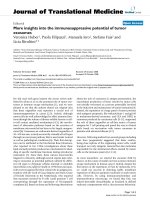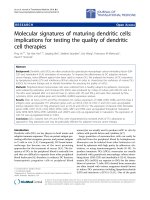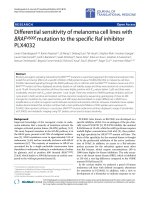báo cáo hóa học:" False aneurysm of the interosseous artery and anterior interosseous syndrome - an unusual complication of penetrating injury of the forearm: a case report" potx
Bạn đang xem bản rút gọn của tài liệu. Xem và tải ngay bản đầy đủ của tài liệu tại đây (431.07 KB, 4 trang )
BioMed Central
Page 1 of 4
(page number not for citation purposes)
Journal of Orthopaedic Surgery and
Research
Open Access
Case report
False aneurysm of the interosseous artery and anterior
interosseous syndrome - an unusual complication of penetrating
injury of the forearm: a case report
Ramon Pini*, Stefano Lucchina, Guido Garavaglia and Cesare Fusetti
Address: Hand Surgery Unit, Ospedale San Giovanni, Bellinzona, Switzerland
Email: Ramon Pini* - ; Stefano Lucchina - ; Guido Garavaglia - ;
Cesare Fusetti -
* Corresponding author
Abstract
Background: Palsies involving the anterior interosseous nerve (AIN) comprise less than 1% of all
upper extremity nerve palsies.
Objectives: This case highlights the potential vascular and neurological hazards of minimal
penetrating injury of the proximal forearm and emphasizes the phenomenon of delayed
presentation of vascular injuries following seemingly obscure penetrating wounds.
Case Report: We report a case of a 22-year-old male admitted for a minimal penetrating trauma
of the proximal forearm that, some days later, developed an anterior interosseous syndrome. A
Duplex study performed immediately after the trauma was normal. Further radiologic
investigations i.e. a computer-tomographic-angiography (CTA) revealed a false aneurysm of the
proximal portion of the interosseous artery (IA). Endovascular management was proposed but a
spontaneous rupture dictated surgical revision with simple excision. Complete neurological
recovery was documented at 4 months postoperatively.
Conclusions/Summary: After every penetrating injury of the proximal forearm we propose
routinely a detailed neurological and vascular status and a CTA if Duplex evaluation is negative.
Introduction
Penetrating isolated lesions of the interosseous anterior
neurovascular bundle are rare. We report the case of a 22-
year-old male who sustained such a lesion with formation
of a false aneurysm of the proximal portion of the interos-
seous artery (IA). A review of the literature showed one
similar case of infective origin so that our description is
the first of post-traumatic vascular compression of the
anterior interosseous nerve (AIN) [1].
Case Report
A 22 year old male sustained a penetrating injury of the
forearm, after falling into a glass window during his stay
in the Far East. The initial haemorrhage was treated with a
simple compression. X-ray showed a small glass-like for-
eign body (fig. 1). A Duplex study was apparently normal.
A few days later, he developed a rapidly complete sensory
deficit on the median nerve and a loss of motor function
on the AIN. No specific therapy or further investigation
was proposed to the patient, who, back home 4 weeks
Published: 24 December 2009
Journal of Orthopaedic Surgery and Research 2009, 4:44 doi:10.1186/1749-799X-4-44
Received: 17 July 2009
Accepted: 24 December 2009
This article is available from: />© 2009 Pini et al; licensee BioMed Central Ltd.
This is an Open Access article distributed under the terms of the Creative Commons Attribution License ( />),
which permits unrestricted use, distribution, and reproduction in any medium, provided the original work is properly cited.
Journal of Orthopaedic Surgery and Research 2009, 4:44 />Page 2 of 4
(page number not for citation purposes)
later, consulted our unit. An established ischemic contrac-
ture (Holden moderate type) was clinically suspected.
Electrophysiological studies confirmed the neurological
lesion, with partial denervation of the flexor pollicis lon-
gus (FPL), coupled with moderate reduction of sensitive
conduction in the median and ulnar nerves. We decided
on surgical exploration. An extensive hematoma in the
flexor's compartment was drained with extraction of the
glass fragment which was lodged exactly in the first motor
bifurcation of the AIN. The main trunk of the AIN was
undamaged (fig. 2). The motor branch was reconstructed
with a nerve graft. In the absence of evidence of a vascular
lesion and active bleeding, a simple fasciotomy was per-
formed before skin closure.
Two days later the arm became newly swollen and pain-
ful. A computer-tomographic-angiography (CTA) (fig. 3)
confirmed a false aneurysm of the IA. An endovascular
embolisation was planned, but suddenly excruciating
pain dictated an immediate surgical revision with aneu-
rysm excision and arterial ligation. A complete neurologi-
cal recovery was documented four months later.
Discussion
Upper extremity injuries constitute 30-50% of all periph-
eral vascular injuries, more than 80% of which are from
penetrating trauma. Radial and ulnar arterial injuries
make up 5-30% of all peripheral vascular injuries [2]. The
most common cause of upper extremity vascular injuries
is penetrating trauma secondary to gunshot wounds, stab
wounds and lacerations from broken glass. However,
iatrogenic traumas secondary to the widespread use of
diagnostic and therapeutic intravascular techniques have
also contributed to the increase in incidence [2,3].
Nerve compression from a false aneurysm is extremely
rare. A review of the literature showed one similar case of
infective origin and two other cases with compression of
the posterior interosseous nerve [1,4,5]. All the other cases
in the arm were related to compression of the brachial
plexus, median and ulnar nerve [6-13]. The peculiarity of
our case report is the neurologic involvement of the AIN.
X-rayFigure 1
X-ray. The arrow shows the glass-like foreign body in the
forearm.
Intraoperative pictureFigure 2
Intraoperative picture. The scissors shows the glass-like
fragment lodged exactly into the first motor bifurcation of
the anterior interosseous nerve (AIN). The main nerve is
undamaged.
Angio-CT-ScanFigure 3
Angio-CT-Scan. False aneurysm of the proximal portion of
the interosseous artery (IA).
Journal of Orthopaedic Surgery and Research 2009, 4:44 />Page 3 of 4
(page number not for citation purposes)
The AIN branches from the median nerve between the two
heads of the pronator teres muscle, just distal to the ori-
gins of the motor branches to the superficial forearm
flexor muscles and then runs with the IA on the anterior
surface of the interosseous membrane, between and deep
into the FPL and flexor digitorum profundus 1+2, which
it supplies [14].
A focused history and thorough physical examination,
combined with a working knowledge of normal vascular
anatomy, can help identify most vascular abnormalities of
the upper extremity. Technologic improvements, such as
Duplex and CTA, now allow accurate diagnosis by non-
invasive methods [15,16]. Nevertheless, our case shows
that in a perforating trauma of the arm a careful neurolog-
ical examination must always be performed, otherwise
minor neurological signs, i.e. FPL dysfunction could pass
unobserved. Although conventional teaching usually
holds that an electro-diagnostic study should not be done
until about 3 weeks after the injury, in fact a great deal of
important information can be obtained by studies carried
out within the first week [17].
For the vascular status, the first additional diagnostic
modality is the Duplex: less expensive, rapidly carried out
and successful in detecting significant lesions such as false
aneurysms, arteriovenous fistulae, and major vessel occlu-
sions [18]. In case of negative or uncertain result, a CTA or
a simple arteriography should be routinely performed
[1,19,20].
Our preoperative diagnosis was a chronic Volkmann's
contracture (Holden moderate type) possibly combined
with a lesion of the AIN. During wound exploration with
a pneumatic tourniquet (250 mmHg) we found a muscu-
lar laceration, an organized hematoma and a lesion of the
first motor branch of the AIN. Our preoperative diagnosis
was confirmed and the neurological deficit was attributed
to compression from the hematoma. This is why the vas-
cular bundle was not explored and the possibility of an
arterial false aneurysm was at first not even considered.
Once the circulation had been restored (pneumatic tour-
niquet off) and the hematoma removed, the aneurysm
had the possibility to re-expand. This explains why the
lesion became clinically and radiologically evident post-
operatively.
Technically we used a proximal anterior approach. The
dissection was difficult due to the old hematoma. We do
not have a clear explanation for the acute bleeding during
the night but do not think that it was due to an iatrogenic
lesion during the first operation.
With regard to the pathogenesis, we assume that the false
aneurysm is the result of a partial laceration of the IA due
to the glass fragment found in the first motor bifurcation
of the AIN. We were not able to visualize the path of the
glass fragment because of the hematoma and the time
lapse between the accident and the exploration. Retro-
spectively, the partial lesion of the IA by the glass fragment
with secondary formation of a false aneurysm can explain
both the hematoma and the anterior interosseous syn-
drome. The glass fragment in the first motor bifurcation
cannot be the sole explanation of the anterior interos-
seous syndrome because the main trunk was intact. The
compression of the AIN from the false aneurysm is, how-
ever, instead a plausible explanation.
For the secondary revision we believe that an endovascu-
lar approach would have been appropriate, to avoid a new
dissection after the first microsurgical suture. Likewise, a
primary endovascular approach could be considered, but
only after a correct preoperative diagnosis and only in the
absence of an extrinsic hematoma as the compression on
the nerve would remain.
However, because it is a rare condition, this kind of
approach has not been described in the literature and in
our case an unexpected rupture of the aneurysm during
the night imposed the classical and simple intervention
with resection of the aneurysm. Similar to the cases
described by Illuminati and Kim the results were optimal
[1,21].
Nowadays, nonsurgical approaches play an important
role in the treatment of peripheral false aneurysms
[16,22]. Endoluminal repair of false aneurysms, large arte-
riovenous fistulas, intimal flaps, and focal lacerations, is
performed by using stent-graft technology. Castelli and
colleagues reported a 100% immediate success rate in
managing axillo-subclavian arterial injuries [23]. In the
study of Onal et al, all the stent-grafts in 17 patients with
iatrogenic, traumatic, or spontaneous vascular lesions,
were deployed successfully [24]. However, careful patient
selection must be emphasized [25]. In the study of
Komorowska-Timek et al, the ultrasound-guided
thrombin injection has been shown to be effective also in
the treatment of peripheral pseudo-aneurysms of the
radial and ulnar artery [26].
Conclusions
Penetrating injuries of the proximal forearm should not
be underestimated because they are a potential cause of
nerve and vascular injury.
While lesions of the major neuro-vascular bundels are
often evident at clinical examination, this might not be
the case for less accessible structures such as the anterior
or posterior interosseous neurovascular bundle. The con-
sequences can be disastrous, with development of sub-
acute compartment syndrome or delayed diagnosis of
Publish with BioMed Central and every
scientist can read your work free of charge
"BioMed Central will be the most significant development for
disseminating the results of biomedical research in our lifetime."
Sir Paul Nurse, Cancer Research UK
Your research papers will be:
available free of charge to the entire biomedical community
peer reviewed and published immediately upon acceptance
cited in PubMed and archived on PubMed Central
yours — you keep the copyright
Submit your manuscript here:
/>BioMedcentral
Journal of Orthopaedic Surgery and Research 2009, 4:44 />Page 4 of 4
(page number not for citation purposes)
neuro-muscular deficits, that have a less favourable func-
tional prognosis.
We believe that for every penetrating injury of the fore-
arm, the emergency physician should perform a detailed
neurological and clinical status, evaluating not only sensi-
bility but also every muscle group. Vascular examination
distal to the lesion is mandatory, although with deep vas-
cular lesions it might initially appear to be normal. As for
clinical examination, Doppler investigation distal to the
lesion is often seem to be normal, initially. We therefore
recommend carrying out a detailed clinical and neurolog-
ical status in association with a Duplex examination of the
injured region, and if there is doubt, a CTA.
Consent
Written informed consent was obtained from the patient
for publication of this case report and accompanying
images.
Competing interests
The authors declare that they have no competing interests.
Authors' contributions
RP has made substantial contributions to conception and
design, or acquisition of data. RP, SL, GG, CF have been
involved in drafting the manuscript or revising it critically
for important intellectual content. RP, SL, GG, CF have
given final approval of the version to be published.
References
1. Illuminati G, Caliò FG, Bertagni A, Vasapollo L, Vietri F, Martinelli V:
Infectious aneurysm of the interosseous artery at the fore-
arm. Case report. J Cardiovasc Surg 1996, 37:589-91.
2. Marrero IC: Hand, Upper Extremity Vascular Injury. Emedicine,
Article Last Updated: Apr 2, 2008 .
3. Puhaindran ME, Wong HP: A case of anterior interosseous nerve
syndrome after peripherally inserted central catheter
(PICC) line insertion. Singapore Med J 2003, 44:653-5.
4. Weinstein RN: False aneurysm presenting as delayed poste-
rior interosseus nerve palsy. J Orthop Trauma 1996, 10:583-5.
5. Dharapak C, Nimberg GA: Posterior interosseous nerve com-
pression. Report of a case caused by traumatic aneurysm.
Clin Orthop Relat Res 1974, 101:225-8.
6. Knabl JS, Walzer LR, Hartel A, Frey M: Total ulnar nerve paralysis
due to acute traumatic aneurysm at the forearm. Handchir
Mikrochir Plast Chir 2002, 34:133-6.
7. Loréa P, Schuind F: False aneurysm appearing as delayed ulnar
nerve palsy after "minor" penetrating trauma in the fore-
arm. J Trauma 2001, 51:144-5.
8. Pfammatter T, Künzli A, Hilfiker PR, Schubiger C, Turina M: Relief of
subclavian venous and brachial plexus compression syn-
drome caused by traumatic subclavian artery aneurysm by
means of transluminal stent-grafting. J Trauma 1998, 45:972-4.
9. Sauerbier M, Krimmer H, Müller L, Lanz U: Compression of the
ulnar nerve in Guyon's canal by a traumatic aneurysm. A
case report. Handchir Mikrochir Plast Chir 1998, 30:303-5.
10. Tarng DC, Huang TP, Lin KP: Brachial plexus compression due
to subclavian pseudoaneurysm from cannulation of jugular
vein hemodialysis catheter. Am J Kidney Dis 1998, 31:694-7.
11. Bauer T, Schütz H, Beer R: Lesion of the brachial plexus caused
by traumatic aneurysma spurium of the axillary artery case
report of two patients. Fortschr. Neurol Psychiatr 1992,
60:437-40.
12. O'Leary MR: Subclavian artery false aneurysm associated with
brachial plexus palsy: a complication of parenteral drug
addiction. Am J Emerg Med 1990, 8:129-33.
13. Habermann ET, Cabot WD: Median nerve compression second-
ary to false aneurysm of the brachial artery. Bull Hosp Joint Dis
1974, 35:158-61.
14. Svizenska I, Cizmar I, Visna P: An Anatomical Study of the Ante-
rior Interosseous Nerve and its Innervation of the Pronator
Quadratus Muscle. J Hand Surg 2005, 30:635-7.
15. Phillips CS, Murphy MS: Vascular problems of the upper
extremity: a primer for the orthopaedic surgeon. J Am Acad
Orthop Surg 2002, 10:401-8.
16. Rasmussen , Todd E, et al.: Development and Implementation of
Endovascular Capabilities in Wartime. The Journal of Trauma:
Injury, Infection, and Critical Care 2008, 64(5):1169-1176.
17. Campbell WW: Evaluation and management of peripheral
nerve injury. Clin Neurophysiol 2008, 119:1951-65.
18. Schwartz M, Weaver F, Yellin A, Ralls P: The utility of color flow
Doppler examination in penetrating extremity arterial
trauma. Am Surg 1993, 59:375-8.
19. Busquéts AR, Acosta JA, Colón E, Alejandro KV, Rodríguez P: Heli-
cal, Computed Tomographic Angiography for the Diagnosis
of Traumatic Arterial Injuries of the Extremities. The Journal
of Trauma: Injury, Infection, and Critical Care 2004:625-628.
20. Peng PD, Spain DA, Tataria M, Hellinger JC, Rubin GD, Brundage SI:
CT angiography effectively evaluates extremity vascular
trauma. Am Surg 2008, 74:103-7.
21. Kim DH, Murovic JA, Kim YY, Kline DG: Surgical treatment and
outcomes in 15 patients with anterior interosseous nerve
entrapments and injuries. J Neurosurg 2006, 104:757-65.
22. Buda SJ, Johanning JM: Brachial, radial, and ulnar arteries in the
endovascular era: choice of intervention. Semin Vasc Surg
2005,
18:191-5.
23. Castelli P, Caronno R, Piffaretti G, Tozzi M, Laganà D, Carrafiello G,
et al.: Endovascular repair of traumatic injuries of the subcla-
vian and axillary arteries. Injury 2005, 36:778-82.
24. Onal B, Ilgit ET, Koar S, Akkan K, Gümü T, Akpek S: Endovascular
treatment of peripheral vascular lesions with stent-grafts.
Diagn Interv Radiol 2005, 11:170-4.
25. Danetz JS, Cassano AD, Stoner MC, Ivatury RR, Levy MM: Feasibil-
ity of endovascular repair in penetrating axillo-subclavian
injuries: a retrospective review. J Vasc Surg 2005, 41:246-54.
26. Komorowska-Timek E, Teruya TH, Abou-Zamzam AM, Papa D, Bal-
lard JL: Treatment of radial and ulnar artery pseudoaneu-
rysms using percutaneous thrombin injection. J Hand Surg
2004, 29:936-42.









